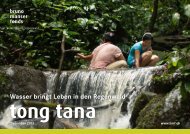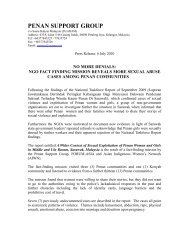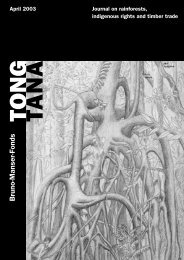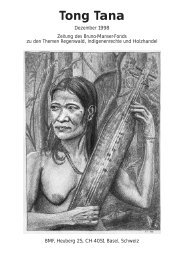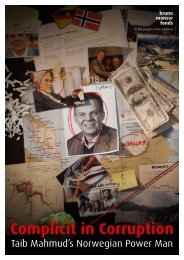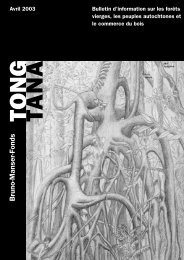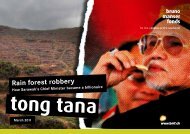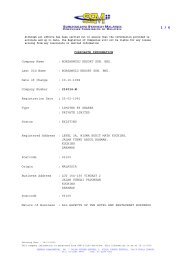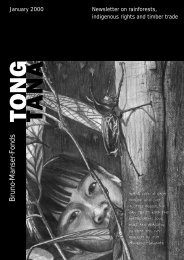The Untouchables. Rimbunan Hijau's world of forest crime & political ...
The Untouchables. Rimbunan Hijau's world of forest crime & political ...
The Untouchables. Rimbunan Hijau's world of forest crime & political ...
- No tags were found...
Create successful ePaper yourself
Turn your PDF publications into a flip-book with our unique Google optimized e-Paper software.
THEUNTOUCHABLES<strong>Rimbunan</strong> Hijau’s<strong>world</strong> <strong>of</strong> <strong>forest</strong> <strong>crime</strong>& <strong>political</strong> patronage
EXECUTIVE SUMMARY<strong>The</strong> global trade in illegal and destructivelylogged timber is now out <strong>of</strong> control.Unlawful access to <strong>forest</strong> resources,environmental damage and <strong>forest</strong> destruction,human rights abuses and social dislocation <strong>of</strong> <strong>forest</strong>dwellingpeoples in some <strong>of</strong> the poorest areas <strong>of</strong> the<strong>world</strong>, are being fuelled by those who buy timberand timber products from these illegal sources.One major player in this field is <strong>Rimbunan</strong> Hijau.<strong>Rimbunan</strong> Hijau is a global conglomerate <strong>of</strong>companies controlled by the Tiong family fromSarawak in Malaysia. Initially built as a timberempire, the company now has extensive interests inlogging, timber processing, publishing, propertyinvestment, new technology and travel.<strong>Rimbunan</strong> Hijau dominates the logging industryin Papua New Guinea and is a powerful industryplayer in Malaysia and Equatorial Guinea. It also hassignificant <strong>forest</strong>ry interests in Gabon, Indonesia,Vanuatu, New Zealand, and Russia. 1In these countries, the operations <strong>of</strong> <strong>Rimbunan</strong>Hijau are <strong>of</strong>ten characterised by a disregard for thelaw with documented illegalities in many aspects <strong>of</strong>their operations.Illegal access to <strong>forest</strong> resources, environmentaldamage and human rights abuses are repeatedcomplaints. But the company seems impervious tocriticism and appears to be protected by anextensive and well-established network <strong>of</strong> <strong>political</strong>patronage and media control.Timber produced by <strong>Rimbunan</strong> Hijau is tradedacross the globe with little concern for theenvironmental damage, misery and sufferingcaused in producer countries.<strong>Rimbunan</strong> Hijau’s illegal timber and timberproducts are being traded across-the-counter inAsia, America, Europe, Japan, Australia and NewZealand.Kuwene Nakeye, a landowner from the Haya clan, Kosuo tribe in a reserve she protected from logging. Kuwene is seen here with her nephew Alex Ubiye.<strong>The</strong>yhave worked together to protect their land from logging by <strong>Rimbunan</strong> Hijau.© Scheltema/GreenpeaceTHIS REPORT• Examines the extent and impact <strong>of</strong> <strong>Rimbunan</strong> Hijau’s (RH) timber operations in five key countries;• Highlights the environmental damage, human rights abuses and social suffering caused by RH;• Reveals some <strong>of</strong> the networks <strong>of</strong> <strong>political</strong> patronage that protect RH;• Details the global trade in illegal timber from RH logging operations;• Suggests simple and effective solutions to <strong>forest</strong> <strong>crime</strong>s and to mitigate the activities <strong>of</strong> companies like RH.2 THE UNTOUCHABLES<strong>Rimbunan</strong> Hijau’s <strong>world</strong> <strong>of</strong> <strong>forest</strong> <strong>crime</strong> & <strong>political</strong> patronage
THE GLOBAL FOREST CRISISAncient <strong>forest</strong>s are fundamental to life on Earth.<strong>The</strong>y provide a home and vital sustenance tomillions <strong>of</strong> people. <strong>The</strong>y provide a habitat forinnumerable species <strong>of</strong> plants and animals. Andthey perform vital ecological functions.Ancient <strong>forest</strong>s are the place that millions <strong>of</strong>indigenous peoples call home. Some <strong>of</strong> thesepeoples constitute the poorest and mostdisadvantaged <strong>of</strong> all <strong>world</strong> citizens. <strong>The</strong>y sufferhuman rights abuses, great poverty, disease andother social problems as <strong>forest</strong> areas are harvested,with little or no consideration for their plight orlivelihoods.“...landowners were forcedto sign papers with abarrel <strong>of</strong> a gun at theirback. In the presence <strong>of</strong>police and company<strong>of</strong>ficials, without properlegal advice, with gunspointed at them.”Annie Kajir, Human Rights Lawyer, PortMoresby, Papua New Guinea. 3Now, just 20percent <strong>of</strong> the Earth’soriginal <strong>forest</strong> coverremains as large intactareas; with more thana third <strong>of</strong> these underthreat. Industrial-scalelogging poses thesingle largest menaceto the <strong>forest</strong>s’survival. 2Across the globe,trans-nationalcorporations continueto operatedestructively, and <strong>of</strong>ten outside <strong>of</strong> the law, as theyharvest the <strong>world</strong>’s last remaining accessible <strong>forest</strong>resources.Malaysian logging company, <strong>Rimbunan</strong> Hijau(RH) is one such corporation.Logging destruction is fuelled by a complacentinternational marketplace. In addition, consumingnations <strong>world</strong>wide, eager to fulfil a relentlessdemand for wood and paper, turn a blind eye to“Some 350 million <strong>of</strong> the poorest people on Earth areentirely dependent on <strong>forest</strong>s for their survival”World Commission on Forests and Sustainable Development 1999. 4the social, environmental and legal problems thatcharacterise the logging operations <strong>of</strong> companieslike <strong>Rimbunan</strong> Hijau.<strong>The</strong> actions <strong>of</strong> <strong>forest</strong> plunderers amount to farmore than just a huge ecological disaster.<strong>The</strong>y have severe impacts on local people and onthe national economies <strong>of</strong> some <strong>of</strong> the LeastDeveloped Countries (LDCs) in the <strong>world</strong>.KEY POINTS1. Much <strong>of</strong> the global trade in timber and timberproducts is unlawful.2. Destructively and illegally extracted timberexacts a ruinous toll on <strong>forest</strong> eco-systems andon the lives <strong>of</strong> <strong>forest</strong>-dwelling peoples. It cheatsdeveloping countries <strong>of</strong> revenue and resourcesnecessary for survival and nationaldevelopment.3. Companies like <strong>Rimbunan</strong> Hijau operate acrossnational boundaries and are a key participant inthe illegal harvesting <strong>of</strong> timber.4. Such companies operate with impunity andcultivate a network <strong>of</strong> <strong>political</strong> patronage thatbreeds <strong>of</strong>f <strong>political</strong> systems that are underimmense stress in Southern nations.5. Only measures at both the producer level (where<strong>forest</strong>s must be protected from illegal anddestructive logging) and at the consumer level(where illegal timber and timber products mustbe identified and banned) willeffectively address the problem.6. International and bilateral<strong>political</strong> processes, such as theConvention for BiologicalDiversity (CBD), are anopportunity for governments t<strong>of</strong>und the protection <strong>of</strong> ancient<strong>forest</strong>s and put in place strictinternational guidelines andprogrammes to achieve the“significant reduction inbiodiversity loss by 2010”, agreedto at the Johannesburg EarthSummit in 2002.Pepsy Diabe, Kamala clan, KusuoTribe stands amidst devastation<strong>of</strong> recent logging, Wawoi Guavi,Papua New Guinea. ©Scheltema/GreenpeaceTHE UNTOUCHABLES 3<strong>Rimbunan</strong> Hijau’s <strong>world</strong> <strong>of</strong> <strong>forest</strong> <strong>crime</strong> & <strong>political</strong> patronage
WHO IS RIMBUNAN HIJAU?<strong>Rimbunan</strong> Hijau is a conglomeration <strong>of</strong> manyhundreds <strong>of</strong> companies spread across threecontinents all owned and controlled by the Tiongfamily but which sometimes have no other <strong>of</strong>ficialconnection.<strong>Rimbunan</strong> Hijau has business interests in Australia,British Guyana, China, Equatorial Guinea, HongKong, Indonesia, Gabon, Malaysia, Aotearoa (NewZealand), Papua New Guinea, Russia, Singapore,Vanuatu and an estimated annual turnover in excess<strong>of</strong> US$1 billion according to the Malaysia-ChinaBusiness Council. 5<strong>The</strong> Tiong family has built <strong>Rimbunan</strong> Hijau into animmense corporate empire that started out as alogging company but which now extends to includeinterests in timber processing, agriculture (cocoa andoil palm), aquaculture, insurance, banking,publishing 6 , optical fibres, information technology,shipping, retailing, travel, real estate and propertydevelopment, mineral and mining development andprint media.<strong>The</strong> business dealings and corporate structure <strong>of</strong><strong>Rimbunan</strong> Hijau as a company are not open ortransparent, particularly as regards its manycorporate shareholdings and takeovers.In Papua New Guinea for example, Greenpeaceresearch has identified over 60 separate companiesas being owned or <strong>political</strong>ly controlled by the Tiongfamily — but only a small minority are openlyacknowledged as being a part <strong>of</strong> the <strong>Rimbunan</strong>Hijau group. <strong>The</strong> ownership and control <strong>of</strong> the rest isobscured by undisclosed buyouts, proxy directors andshareholders, outdated company records, foreignownership and widespread use <strong>of</strong> tax havens. 7MALAYSIAN MULTINATIONALLOGGING COMPANIESMultinational Malaysian logging companies gottheir start in Malaysia’s rain<strong>forest</strong>s.Malaysian logging companies are <strong>of</strong>ten registeredas family-owned private limited companies, allowingthem to operate secretly as they are not publiclylisted corporations.Many <strong>of</strong> these companies have <strong>political</strong>connections that helped them secure large areas <strong>of</strong><strong>forest</strong>.Within a couple <strong>of</strong> decades they left large areas <strong>of</strong>Malaysia de<strong>forest</strong>ed.Less than 15 percent <strong>of</strong>Malaysia’s <strong>forest</strong>s todayremain intact 8 .After years <strong>of</strong>destructive loggingpractices, the Malaysiangovernment began toenact stricter regulationsto attempt to save whatlittle rain<strong>forest</strong> was leftin the country. Thiscaused the Malaysiancompanies to lookelsewhere for lumber —a path which led themto Indonesia, Papua NewGuinea and other parts<strong>of</strong> the <strong>world</strong>.Equipment at an RHlogging camp in Kandrian,Papua New Guinea© Solness/Greenpeace"Established in 1975, <strong>Rimbunan</strong> Hijau Group has adiversified portfolio <strong>of</strong> businesses with estimated annualturnover exceeding USD 1 billion, withmost items exported. Currently comprising 10,000employees in Malaysia, the Group continues to expand,including diversifying overseas. Over theyears, <strong>Rimbunan</strong> Hijau Group has built up extensiveexperience in logging, sawmilling, export <strong>of</strong> logs andsawntimber and downstream processing activities,ranging from plywood to medium density fibreboardand particleboard. <strong>Rimbunan</strong> Hijau Group is also apioneer in supporting Sarawak's emphasis ondownstream activities. In 1985, it established the state'sfirst large scale plywood mill under <strong>Rimbunan</strong> HijauPlywood Sdn. Bhd. <strong>The</strong> Group is also the majorshareholder <strong>of</strong> Jaya Tiasa Holdings Bhd and Subur TiasaHoldings Bhd, the public listed companies on the KualaLumpur Stock Exchange with market capitalisation <strong>of</strong>about more than RM 2 billion and the largest plywood,veneer and particleboard producer inMalaysia.In addition to its operations in Malaysia,<strong>Rimbunan</strong> Hijau Group has expanded internationally toPapua New Guinea, New Zealand, Australia, China, HongKong, Singapore, Gabon, Rusia, Congo, EquatorialGuinea & British Guyana." 9Malaysian German Chamber <strong>of</strong> Commerce and Industry4 THE UNTOUCHABLES<strong>Rimbunan</strong> Hijau’s <strong>world</strong> <strong>of</strong> <strong>forest</strong> <strong>crime</strong> & <strong>political</strong> patronage
POLITICAL PATRONAGE<strong>Rimbunan</strong> Hijau enjoys wide <strong>political</strong> patronage.In Malaysia the Tiongs have been highly astute informing strategic alliances with the Malay <strong>political</strong>elite and are personally involved in the SUPP – themain Chinese Party in Sarawak.In the early nineties, the brother <strong>of</strong> Sarawak’sChief Minister (who controled the allocation <strong>of</strong>logging concessions) was a director <strong>of</strong> a <strong>Rimbunan</strong>Hijau company and a sister <strong>of</strong> the Chief Ministerwas a Tiong business partner.Tiong Hiew King has himself been a StateSenator, a position that was also occupied by one <strong>of</strong>his sons, and Tiong family companies have sharedcontrol <strong>of</strong> their subsidiaries with Provincial Ministersand party <strong>of</strong>ficials. 10In Sarawak these ties have resulted in a blurring<strong>of</strong> the distinction between government and logginginterests and has led “to changes in legislation thatfavour corporate activities and which result in thedisregard and repression <strong>of</strong> many actors within civilsociety.” 11In Papua New Guinea <strong>Rimbunan</strong> Hijau is alsoclosely connected to the <strong>political</strong> elite.For example, one recent Deputy Prime Ministerwas criticised in an Ombudsman investigation forunlawfully pressuring the National Forest Board t<strong>of</strong>avour <strong>Rimbunan</strong> Hijau with an illegal timberpermit extension. 12<strong>The</strong> Minister for Justice is Chair <strong>of</strong> a companythat holds a timber permit that it sub-contracts to<strong>Rimbunan</strong> Hijau. A National IntelligenceOrganisation report alleges a provincial Governorand two Members <strong>of</strong> Parliament were on <strong>Rimbunan</strong>Hijau’s payroll. 13CORPORATE RESPONSIBILITYOffice <strong>of</strong> the National newspaper,which is owned by <strong>Rimbunan</strong>Hijau, in Port Moresby, Papua NewGuinea © Solness/Greenpeace<strong>Rimbunan</strong> Hijau is just one <strong>of</strong> a number <strong>of</strong>Malaysian companies that have global timberinterests. Many <strong>of</strong> these companies have beencriticised for poor environmental, social and humanrights records. 14If Malaysia is to be seen as a good global citizenthis attitude must change. Malaysia will attempt toportray a commitment to the environment whenhosting the Seventh Conference <strong>of</strong> the Parties(COP7) <strong>of</strong> the United Nations Convention onBiological Diversity in Kuala Lumpur in February2004.Globally, there are growing calls forgovernments to hold transnational corporationsaccountable for their actions in foreign countries.This is especially important for companies operatingin smaller or less developed countries where therule <strong>of</strong> law and governance frameworks may beweak.<strong>The</strong> final text <strong>of</strong> the Johannesburg Earth Summit– the World Summit on Sustainable Development –made a positive statement on corporateaccountability. WSSD called for: “Active promotion<strong>of</strong> corporate responsibility and accountabilityincluding through the full development andeffective implementation <strong>of</strong> intergovernmentalagreements and measures.”Malaysia is a signatory to the WSSD plan <strong>of</strong>implementation and must start to make its rhetoricmatch its actions.In order to make real its commitment to WSSD,the Malaysian government must consider:• Pursuit <strong>of</strong> amendments to its Corporations Lawto increase corporate accountability;• Passage <strong>of</strong> legislation to impose standards onMalaysian companies operating overseas;• Actively supporting international mechanismsthat increase the accountability <strong>of</strong> itstransnational corporations.THE UNTOUCHABLES 5<strong>Rimbunan</strong> Hijau’s <strong>world</strong> <strong>of</strong> <strong>forest</strong> <strong>crime</strong> & <strong>political</strong> patronage
PAPUA NEW GUINEAGuinea’s only veneer mill andits largest sawmill.In Papua New Guinea<strong>Rimbunan</strong> Hijau controlscompanies involved incommercial printing, travel,wholesale and retail sales,shipping, propertydevelopment and owns adaily newspaper, <strong>The</strong>National.<strong>Rimbunan</strong> Hijau has closeconnections to Papua NewGuinea’s <strong>political</strong> elite. <strong>The</strong>Prime Minister has beendirectly involved in thelogging industry 16 and hisDeputy has been criticised inan Ombudsman Commissionreport for ‘arbitrary andirresponsible’ interference indirecting the unlawfulallocation <strong>of</strong> the Kamula Dosalogging concession to<strong>Rimbunan</strong> Hijau. 17Wawoi Falls from the air, Wawoi Guawi, Papua New Guinea.© GreenpeacePapua New Guinea is a South Pacific nation <strong>of</strong>some five million people, most <strong>of</strong> who still dependon the environment for their daily subsistence.<strong>The</strong> logging industry has already acquired 70percent <strong>of</strong> available <strong>forest</strong> resources and <strong>Rimbunan</strong>Hijau is at the forefront <strong>of</strong> attempts to gain accessto what remains.RIMBUNAN HIJAU IN PNG<strong>Rimbunan</strong> Hijau is the dominant player in the<strong>forest</strong> industry in Papua New Guinea and it hassignificant investments in other sectors <strong>of</strong> theeconomy.<strong>Rimbunan</strong> Hijau maintains a veil <strong>of</strong> secrecy overthe true extent <strong>of</strong> its logging and other businessinterests but it has interests in more than 60interlinked companies that are registered in PapuaNew Guinea.<strong>The</strong>se companies control more than 50 percent<strong>of</strong> Papua New Guinea’s large-scale commerciallogging operations and at least 55 percent <strong>of</strong> logexports.Greenpeace estimates that <strong>Rimbunan</strong> Hijaucontrols timber rights in more than three millionhectares <strong>of</strong> <strong>forest</strong> and in 2002 alone, exported logsworth more than US$50 million from Papua NewGuinea. 15<strong>Rimbunan</strong> Hijau also operates Papua New<strong>The</strong> Secretary <strong>of</strong> theDepartment <strong>of</strong> Environmentand Conservation was also criticised by theOmbudsman Commission for his role in the sameaffair.<strong>The</strong> Minister for Justice is the Chair <strong>of</strong> acompany 18 that holds the permit for the East Kikorilogging concession. His company employs<strong>Rimbunan</strong> Hijau as its logging contractor.<strong>The</strong> Minister for Planning, the Minister forPrivatisation and the Chief Secretary are otherprominent leaders with well-documented links tothe logging industry in PNG. 19<strong>The</strong> rain<strong>forest</strong>s <strong>of</strong> Papua New Guinea and Asia Pacific shelterregions <strong>of</strong> unusually high biodiversity. © Dorreboom/Greenpeace6 THE UNTOUCHABLES<strong>Rimbunan</strong> Hijau’s <strong>world</strong> <strong>of</strong> <strong>forest</strong> <strong>crime</strong> & <strong>political</strong> patronage
RIMBUNAN HIJAU AND ILLEGAL LOGGINGMost large-scale logging operations in PapuaNew Guinea, including those operated by<strong>Rimbunan</strong> Hijau, are unlawful as they are infundamental breach <strong>of</strong> a number <strong>of</strong> basic legalrequirements.Most logging operations do not have theinformed consent <strong>of</strong> the local resource owners(most <strong>of</strong> whom have never even been correctlyidentified) 20 , they have not been initiated andallocated according to the requirements <strong>of</strong> theForestry Act, they are being operated in almostcomplete defiance <strong>of</strong> environmental laws andregulations and they are not sustainable, which is aspecific requirement <strong>of</strong> both the PNG Constitutionand the Forestry Act. 21An independent review was recently ordered bythe government into a number <strong>of</strong> new loggingpermits and extensions. 22 Three <strong>of</strong> the reviewsinvolved logging projects operated by <strong>Rimbunan</strong>Hijau; Wawoi Guavi, Vailala Blocks 2 and 3 andPassismanua.<strong>The</strong> review found that the extensions to all threeprojects were unlawful as they breached legalrequirements and had not followed due process.<strong>The</strong> review reached the ‘unavoidable conclusionthat there have been serious departures andbreaches from due process and there are seriousanomalies in the timber permits and agreements’. 23As well as declaring the project extensionsunlawful, the review also found that the originaltimber permits for Vailala Blocks 2 and 3 andWawoi Guavi were also unlawful and that thetimber rights had never been properly acquiredfrom the landowners. 24<strong>Rimbunan</strong> Hijau managed to keep itsinvolvement in the unlawful extension <strong>of</strong> thePassismanua timber permit out <strong>of</strong> the PNG media bythreatening a defamation action against the PostCourier newspaper. 25 <strong>Rimbunan</strong> Hijau’s denial <strong>of</strong>involvement to the media was contradicted in thesubsequent review, which confirmed that RH wasthe logging company for Passismanua. 26KAMULA DOSAKamula Dosa is Papua New Guinea’s largestunallocated logging concession in the western part<strong>of</strong> the country. It covers over 800,000 hectares andcontains an estimated 11.2 million cubic metres <strong>of</strong>commercial timber.<strong>The</strong> concession is the biggest prize currentlyavailable to the logging industry in PNG and it iscoveted by a number <strong>of</strong> logging companiesincluding <strong>Rimbunan</strong> Hijau.Forestry laws require that the timber rights bepublicly advertised in acompetitive biddingprocess to ensure thebest possible deal forthe local resourceowners. But <strong>Rimbunan</strong>Hijau has made anumber <strong>of</strong> attempts toavoid this process andto unlawfully acquirethe logging rights.In 1997 <strong>Rimbunan</strong>Hijau was granted anunlawful geographicalextension to its WawoiGuavi timber permitthat covered the whole<strong>of</strong> the Kamula Dosaconcession area. <strong>The</strong>extension wassubsequentlyinvestigated andoverturned by theOmbudsmanCommission. 27<strong>The</strong> Ombudsmancriticised a number <strong>of</strong>politicians forinfluencing the decision<strong>of</strong> the National ForestBoard and Boardmembers for floutingthe law and putting theinterests <strong>of</strong> RH abovethose <strong>of</strong> the resourceowners and the State. 28<strong>The</strong> Ombudsmanrecommended actionagainst a number <strong>of</strong>Board Members and<strong>Rimbunan</strong> Hijau, butthose recommendationshave not beenenforced.In 2002, <strong>Rimbunan</strong>Hijau again tried tounlawfully secure thelogging rights forKamula Dosa. A Cabinet submission sponsored bythe then Deputy Prime Minister and a number <strong>of</strong> hisMinisterial colleagues proposed that <strong>Rimbunan</strong>Hijau should be given unique tax concessions andunlimited access to Kamula Dosa without having t<strong>of</strong>ollow the legal allocation process or properprocedures.<strong>The</strong> submission was withdrawn after it waspublicly exposed.ROBBER BARONS<strong>The</strong> latest <strong>of</strong>ficial inquiry intothe <strong>forest</strong>ry sector in Papua NewGuinea found that all six newpermits and permit extensionsreviewed were unlawful. This ishow the Review <strong>of</strong> DisputedForest Allocations, 2003,described the logging companiesoperating in PNG:‘the overwhelming conclusionis that the robber barons are nowas active as they ever were. <strong>The</strong>yare not only free to roam, but arein fact encouraged to do so bypersons whose proper role is toexercise control over them...Onlya Commission <strong>of</strong> Inquiry couldhope to unearth the entirepicture and unravel the web <strong>of</strong>deceit’. 29<strong>The</strong> Review looked specificallyat two <strong>of</strong> <strong>Rimbunan</strong> Hijau’slargest logging operations,Wawoi Guavi and Vailala. Inrespect <strong>of</strong> these two concessionsthe Review stated:‘<strong>The</strong> time has come for a fullinvestigation into the affairs <strong>of</strong>these companies (both RHsubsidiaries). <strong>The</strong>y should becompelled to produce documentsand account for their actions’. 30Despite these findings thePrime Minister has said:“I must congratulate<strong>Rimbunan</strong> Hijau for investingheavily in the <strong>forest</strong>rysector...(this) is in line withgovernment policies...<strong>The</strong>company and other genuine<strong>forest</strong>ry companies must besupported.” 31THE UNTOUCHABLES 7<strong>Rimbunan</strong> Hijau’s <strong>world</strong> <strong>of</strong> <strong>forest</strong> <strong>crime</strong> & <strong>political</strong> patronage
Wawoi Guavi timber concessions,Papua New Guinea.THE ENVIRONMENTAL IMPACTSOF LOGGINGEnvironmental studies 40 indicatethat logging by <strong>Rimbunan</strong> Hijau inPapua New Guinea is among the mostenvironmentally destructive <strong>of</strong> anyselective logging operations studied anywhere onthe planet. Losses to the residual stand have beenrecorded at more than 100 trees per hectare. Whatis supposed to be selective logging is effectivelyclear felling.<strong>The</strong> logging mainly ignores the prescriptions inthe PNG Logging Code <strong>of</strong> Practice. Buffer zones arenot respected, logging tracks are bulldozed throughstreams, poor road construction wastes logs andpollutes water courses, oil and other wastepollution is endemic, standing water attractsmosquitos and increases the incidence <strong>of</strong> malaria,and undersized logs are constantly felled. 41Papua New Guinea’s Constitution and ForestryAct require that all <strong>forest</strong> operations are carried outin a sustainable manner and that resources areprotected for future generations. In reality, theseprescriptions are ignored and the average life <strong>of</strong> alogging concession is just 12 years. 42 This is less thanone-third <strong>of</strong> the legally mandated 40-year cuttingcycle and is also ecologically inadequate.NO MONITORING OR ENFORCEMENTDespite the very poor environmentalperformance <strong>of</strong> logging companies in PNG, noaction is ever taken against them. <strong>The</strong> Department<strong>of</strong> Environment and Conservation does not evenhave a <strong>forest</strong>ry monitoring team and the 2002Ombudsman Commission found that theDepartment head, Wari Iamo has gone out <strong>of</strong> hisway to support <strong>Rimbunan</strong> Hijau. 43Wari Iamo has been criticised by the OmbudsmanCommission for neglect <strong>of</strong> duty for supporting anillegal logging permit extension for <strong>Rimbunan</strong>Hijau. When disciplinary proceedings were initiatedagainst him by his former Minister for a series <strong>of</strong><strong>of</strong>fences, the Prime Minister himself intervened,sacking his Minister and re-instating the suspendedSecretary.WAWOI GUAVIIn an unpublished report 44 commissioned byGreenpeace, scientist Dr David Melick has studiedthe environmental impacts <strong>of</strong> logging by <strong>Rimbunan</strong>Hijau in its Wawoi Guavi timber concession inWestern Province.<strong>The</strong> research uncovered an extensive catalogue<strong>of</strong> breaches <strong>of</strong> PNG’s Logging Code <strong>of</strong> Practice. <strong>The</strong>report identified 261 separate breaches <strong>of</strong> 18 keylogging standards.<strong>The</strong>se breaches were seen to have seriousenvironmental impacts, including injury towaterways and watersheds, severe erosion andserious pollution to soil and waterways from oil andtoxic chemicals.<strong>The</strong> study also found frequent damage tocultural sites from logging operations and thefelling and removal <strong>of</strong> undersized trees.Although Greenpeace and Dr Melick were in thearea at the invitation <strong>of</strong> landowners, <strong>Rimbunan</strong>Hijau used the Southern Command Police Task forceto try andintimidatethem and torestrict accessinto the <strong>forest</strong>.RH also placedlocked chainsand logs acrossroads toinhibitmovement inthe area.“Having examined some <strong>of</strong> thelogging operations, it is nowdifficult to view the responsibleenvironmental position espousedon behalf <strong>of</strong> <strong>Rimbunan</strong> Hijau withanything other than cynicism”(Melick 2003)THE UNTOUCHABLES 9<strong>Rimbunan</strong> Hijau’s <strong>world</strong> <strong>of</strong> <strong>forest</strong> <strong>crime</strong> & <strong>political</strong> patronage
INDONESIAIndonesia has 10 percent <strong>of</strong> the <strong>world</strong>’sremaining tropical <strong>forest</strong>s. <strong>The</strong>y are home to some50 million indigenous people. <strong>The</strong>se <strong>forest</strong>s teemwith unique wildlife and the highest diversity <strong>of</strong>trees and vines found anywhere in the <strong>world</strong>.Hundreds <strong>of</strong> unique mammal and bird specieslive in the <strong>forest</strong>s <strong>of</strong> Indonesia, <strong>of</strong>ten only on asingle island.Yet, if the current rates <strong>of</strong> logging and <strong>forest</strong>conversion continue, the lowland dry <strong>forest</strong>s <strong>of</strong>Sumatra and Indonesian Borneo will have beencompletely destroyed by 2010. 45Indonesia is one <strong>of</strong> the major sources <strong>of</strong> illegallytraded tropical timber. According to governmentestimates, as much as 90 percent <strong>of</strong> the country’sproduction is unlawful, amounting to some 50million cubic metreseach year. 46“<strong>Rimbunan</strong> Hijau hasbecome one <strong>of</strong> the mostruthless logging companiesin the <strong>world</strong> due to abuses<strong>of</strong> national laws andregulations, human rightsviolations and contractualbreaches”Richard Wilcox. Asian Economies FuelForest Meltdown, published in<strong>The</strong> New Observer 47Evidence shows thatthis illegal productionand trade is continuingdespite a log exportban introduced inIndonesia in November2001 48 . <strong>The</strong> primarydestination <strong>of</strong> illegaltimber exports fromIndonesia is Malaysiawhere log imports arecontinuing, despite aban on log importsfrom Indonesiaintroduced in June2002.In October 2003, the Indonesian Minister <strong>of</strong>Forestry called on the European Union to rejecttimber products from Malaysia, saying that theycontain a large amount <strong>of</strong> illegal wood fromIndonesia. 49In Indonesia, much <strong>of</strong> the logging is unlawfulbecause it is done without a government permit orlicence. This is possible because <strong>of</strong> the bribes thatare paid to police, <strong>forest</strong>ry <strong>of</strong>ficials and politicians. 50Kidnapping, bribery and attempted murder have allbeen documented as the methods used by thelogging companies to protect their illegal trade. 51ILLEGAL LOGGING, RIMBUNAN HIJAU ANDTHE MILITARY“Military involvement in illegal activities is takenfor granted in Indonesia. Hundreds <strong>of</strong> reports <strong>of</strong>military involvement in illegal logging haveemerged and there is recognition <strong>of</strong> this seriousproblem within government. Reports <strong>of</strong> militarypersonnel owning illegal sawmills, backing timberbarons and applying pressure for the release <strong>of</strong>confiscated logs are common and widespread.” 52<strong>The</strong> Environment Investigation Agency (EIA) 53 inLondon and the Indonesian group Telapak havereported links between the company PT <strong>Rimbunan</strong>Hijau Jaya and the Indonesian military. EIA andTelapak visited communities in West Papua andobtained documents clearly linking a military <strong>of</strong>ficerto PT <strong>Rimbunan</strong> Hijau Jaya and illegal logging.In a brief presented to the IndonesianGovernment they described how the illegal loggingis being facilitated by the use <strong>of</strong> ‘military power’that is used to threaten local communities. 54Illegal logging by PT <strong>Rimbunan</strong> Hijau Jaya hasbeen reported at three sites and is occurring despitethe opposition <strong>of</strong> the majority <strong>of</strong> the local people.Letters <strong>of</strong> complaint were sent to <strong>forest</strong>ry <strong>of</strong>ficialsin 2002 but a promisedinvestigation has nevereventuated.<strong>The</strong> EIA and Telapak havecalled on the IndonesianGovernment to take decisiveaction to prevent the export <strong>of</strong>illegally felled logs and todiscipline and prosecutemilitary <strong>of</strong>ficers involved withlogging companies in illegalactivities.Merbau Logs cut on Knasaimos land © EIA/Telapak 200310 THE UNTOUCHABLES<strong>Rimbunan</strong> Hijau’s <strong>world</strong> <strong>of</strong> <strong>forest</strong> <strong>crime</strong> & <strong>political</strong> patronage
Landowner Sakas Aomono is dressedin the traditional warrior gear, usedwhen going out fighting.Aonoma’s grandparents used the localBula creek as medicine. “<strong>The</strong>y woulduse this creek when they were sick, itwould make them better. This creekhas faded away. It cannot heal peoplebecause they came and disturbed thebeliefs we have. It will not be thesame as before. <strong>The</strong>re’s no fish sincethe company came. Before my motherand father used to do this, now thereis nothing. Our medicine is not likebefore.Sakas Aonomo from Bula Creek, Middle Fly District, Western Province, PNG© Scheltema/Greenpeace“By looking at that place I feel verysad and upset and frustrated aboutmy land being destroyed”.EQUATORIAL GUINEA<strong>Rimbunan</strong> Hijau operates in a number <strong>of</strong>African countries including Gabon andEquatorial Guinea, where its subsidiaryShimmer International and its manyassociated companies have been a dominantplayer in the logging sector 55 under the“sponsorship <strong>of</strong> the Minister for Forests” 56 ,who is also the President’s son 57 .In Equatorial Guinea, some 70 percent <strong>of</strong>the <strong>forest</strong> has been allocated for large-scaleindustrial logging 58 despite the importance <strong>of</strong>the <strong>forest</strong> for the daily subsistence <strong>of</strong> thelargely rural population.Although local laws require that 60percent <strong>of</strong> log production must be processedon-shore, most timber is still being exportedas cheap raw logs 59 . This deprives the country<strong>of</strong> resource revenues, economic investmentand employment opportunities.Enforcement <strong>of</strong> legal requirements isvirtually non-existent in commercial logging,according to the World Rain<strong>forest</strong> Movement(WRM) and although logging companies arerequired by law to provide health, educationand social facilities for local communities,enforcement is very poor. 60About 85 per cent <strong>of</strong>the African rain<strong>forest</strong>that once spread acrossEquatorial Guinea,Cameroon, CentralAfrican Republic,Congo Brazzaville, theDemocratic Republic <strong>of</strong>Congo and Gabon hasbeen lost. Industriallogging threatens most<strong>of</strong> what remains.© Mauthe/GreenpeaceTHE UNTOUCHABLES 11<strong>Rimbunan</strong> Hijau’s <strong>world</strong> <strong>of</strong> <strong>forest</strong> <strong>crime</strong> & <strong>political</strong> patronage
MALAYSIAA <strong>Rimbunan</strong> Hijau logging tractor and feller team works in a logging concession in the middle Baram valley, Malaysia. © Dang/GreenpeaceMalaysia is one <strong>of</strong> the <strong>world</strong>’s major producersand exporters <strong>of</strong> tropical timber. It is the home basefor <strong>Rimbunan</strong> Hijau and a number <strong>of</strong> other majortransnational logging companies.<strong>The</strong> majority <strong>of</strong> Malaysia’s timber productioncomes from Sarawak where about 70 percent <strong>of</strong> the“Our <strong>forest</strong> and land have been supplying us withabundant resources and providing us with sources <strong>of</strong>income and have also shaped our culture, beliefs andcustoms. Thus, to destroy the <strong>forest</strong> has the sameimpact <strong>of</strong> destroying our community.”Long Sayan Declarationland area has been allocated for logging. Here,<strong>Rimbunan</strong> Hijau has an estimated 800,000 hectares<strong>of</strong> production <strong>forest</strong>. 61<strong>Rimbunan</strong> Hijau produces 3-4 million cubicmetres <strong>of</strong> logs per year, which gives the company a20-25 percent share <strong>of</strong> the Malaysian timberindustry. 62SOCIAL IMPACTS OF LOGGINGLogging companies active in Sarawak are wellknownto indigenous dyak peoples for seriouslyundermining their livelihoods and survival.Widely documented negativesocial consequences <strong>of</strong> thelogging industry include a severeimpact on food security, pollution<strong>of</strong> water supplies, increasingincidences <strong>of</strong> ill-health anddisease, the disruption <strong>of</strong> localeconomies and changes in socialstability. 63“Members <strong>of</strong> ourcommunity aresuffering frompoor health dueto the lack <strong>of</strong> abalanced dietand air andwater pollutioncaused byloggingactivities.”Long Sayan DeclarationIn 2002, the Penan people documented theabuses they have suffered at the hands <strong>of</strong> thelogging industry in the Long Sayan Declaration. 64<strong>The</strong> Penan are particularly affected as they are asemi-nomadic <strong>forest</strong> dwelling people- their <strong>forest</strong>has been their home for thousands <strong>of</strong> years. <strong>The</strong>irfight against logging is a fight for their lives.Over 700 people from 40 communitiesformulated the Declaration to clearly spell out theirsuffering as a people displaced and abused by thelogging industry.<strong>The</strong> Declaration details the food shortages,frequent illnesses and income loss brought about bylogging operations and calls for immediategovernment action as the very survival <strong>of</strong> the Penanpeople is severely threatened by the loggingindustry, which continues to reap huge pr<strong>of</strong>its fromthe sales <strong>of</strong> timber resources extracted from theirancestral land with impunity.12 THE UNTOUCHABLES<strong>Rimbunan</strong> Hijau’s <strong>world</strong> <strong>of</strong> <strong>forest</strong> <strong>crime</strong> & <strong>political</strong> patronage
As is the case in Papua New Guinea, Indonesiaand Africa, Malaysia also suffers severe anduncontrolled environmental impacts from loggingactivities.Careless and negligent logging practices impacton local watersheds and cause soil erosion; theydisrupt local climates and cause or exacerbate <strong>forest</strong>fires. <strong>The</strong>re is also a toll on bio-diversity within<strong>forest</strong>s, and the marine environment.A report by the World Rain<strong>forest</strong> Movement(WRM) and Forests Monitor in 1998, listed a number<strong>of</strong> Malaysian citizens who had their human rightsabused and freedom <strong>of</strong> movement restricted as aresult <strong>of</strong> their opposition to illegal logging. In eachcase, the named individuals had been prevented bygovernment <strong>of</strong>ficials from travelling to attendinternational meetings and then had their passportswithdrawn. 65<strong>The</strong>re is evidence that <strong>Rimbunan</strong> Hijau is nowtrying to apply similar tactics in Papua New Guinea.In November 2003, threats were issued to a localairline to only fly RH approved passengers to anairstrip inside its Wawoi Guavi logging concessionand to deny travel to any non-governmentorganisations. 66<strong>The</strong> top politicians in Sarawak havelong been awarding loggingconcessions to themselves, theirfamilies and their supporters.”WRM and Forest Monitor (1998)and other destructive development activities withintheir customary land and against infringement <strong>of</strong>their rights. In response they have been harassed,intimidated, suppressed and arrested by thegovernment and companies.Supporting these company interests, police and<strong>forest</strong> department <strong>of</strong>ficials have arbitrarily arrestedand detained those indigenous people who put upany form <strong>of</strong> protest, even though such protests areundertaken within the confines <strong>of</strong> their own landsand they have legitimate rights under the law tosuch forms <strong>of</strong> protest. 67In one such protest inAugust 2000, more than100 Penan people in theApoh and Tutoh regionsbarricaded a loggingroad to prevent accessby three timbercompanies including asubsidiary <strong>of</strong> <strong>Rimbunan</strong>Hijau. 68“<strong>The</strong> activities <strong>of</strong> theSarawak timber company<strong>Rimbunan</strong> Hijau havewreaked environmental andsocial havoc in Sarawak foryears through theirwidespread loggingactivities.”Utusan Konsumer, Penang, (Nov 1993) 69<strong>The</strong> action was takenafter numerous verbaland written appeals buttheir problems wereignored. <strong>The</strong> peopleaccuse the loggingcompanies <strong>of</strong> hiringgangsters to threaten them not to pursue theirclaims <strong>of</strong> encroachment, illegal logging anddamage to fruit gardens and burial sites.Protests and blockades continued through 2002and 2003.SOCIAL CONFLICTAND HUMANRIGHTS ABUSES INSARAWAKIndigenous peoplesin Sarawak have lodgedmany complaints to theauthorities aboutlogging-related andland rights problems,but their complaintshave constantly beenignored.Over the last 20years, thousands <strong>of</strong>indigenous dyak peoplein Sarawak have beenblockading andprotesting againstlogging, plantationsPreviously logged Malaysian <strong>forest</strong>s in the early morning fog. A <strong>Rimbunan</strong> Hijau logging road is just visible in the foreground.© Dang/GreenpeaceTHE UNTOUCHABLES 13<strong>Rimbunan</strong> Hijau’s <strong>world</strong> <strong>of</strong> <strong>forest</strong> <strong>crime</strong> & <strong>political</strong> patronage
RUSSIASpread over 774 million hectares, Russia has thebiggest <strong>forest</strong> area in the <strong>world</strong>. This representsabout 24 percent <strong>of</strong> all the <strong>forest</strong>s on our planet.About two-thirds <strong>of</strong> these <strong>forest</strong>s are located in theremote northern regions <strong>of</strong> Siberia and in the FarEast.In the more densely populated areas <strong>of</strong>European Russia, Southern Siberia and parts <strong>of</strong> theFar East, <strong>forest</strong>s have been severely over-loggedduring the last 50 years, placing great pressure onremaining resources.All Russian <strong>forest</strong>s are State-owned; with noprivate ownership. <strong>The</strong> State is responsible forprotection and management <strong>of</strong> <strong>forest</strong>s, even inconcession areas. <strong>The</strong> <strong>forest</strong> service is the biggest inthe <strong>world</strong>, employing about 220,000 people.Environmental activists in the Russian Far Eastare becoming increasingly concerned about theextent <strong>of</strong> illegal logging in the region.<strong>The</strong>y say the rich timber resources <strong>of</strong> the ancient<strong>forest</strong>s are being plundered despite Russia’s strictlaws on logging. Environmentalists blamecorruption by local <strong>of</strong>ficials and lack <strong>of</strong> funds toenforce controls on timber shipments. 70<strong>Rimbunan</strong> Hijau has been operating in Russiasince 1997 when it acquired the rights to harvest305,000 hectares <strong>of</strong> State <strong>forest</strong> in a region that hadbeen earmarked for environmental protection. 71Since 1997, RH has acquired further large-scaleconcession areas in the Ul’chsky/Solnechny andVaninsky districts.<strong>The</strong> Forest Club <strong>of</strong> Russia have expressedconcerns about <strong>Rimbunan</strong> Hijau’s loggingoperations:“Logging in the upstream <strong>of</strong> river Soukpai by theRH company will result in destruction <strong>of</strong> theexisting <strong>forest</strong> ecosystems <strong>of</strong> the basin, spreading<strong>of</strong> <strong>forest</strong> fires, soil erosion and disturbance to thehydrologic balance <strong>of</strong> local rivers... that now servesas an important sources <strong>of</strong> means <strong>of</strong> subsistencefor most <strong>of</strong> the local residents.” 72<strong>Rimbunan</strong> Hijau has been repeatedly fined forviolations <strong>of</strong> logging regulations and environmentallaws. 73In 2002, <strong>Rimbunan</strong> Hijau exported 700,000 cubicmeters <strong>of</strong> timber from Russia with a value <strong>of</strong> US$58million (2001). 74 Seventy-six percent <strong>of</strong> this was soldto China. Most <strong>of</strong> this trade is believed to be withsmall buyers around the border town <strong>of</strong> Suienghe.<strong>The</strong> remaining 24 percent was exported to PacificBarter Trade Limited in Hong Kong.Region where <strong>Rimbunan</strong> Hijau already has <strong>forest</strong>concessionsRegion where <strong>Rimbunan</strong> Hijau plans to secure<strong>forest</strong> concessions14 THE UNTOUCHABLES<strong>Rimbunan</strong> Hijau’s <strong>world</strong> <strong>of</strong> <strong>forest</strong> <strong>crime</strong> & <strong>political</strong> patronage
NEW ZEALAND/ AOTEAROA<strong>Rimbunan</strong> Hijau has committed to FSC in New Zealand but still has away to go to improve plantation management, especially streamprotection. © GreenpeaceAlthough the <strong>forest</strong> industry in New Zealand/Aotearoa is based on the plantation production <strong>of</strong>s<strong>of</strong>twood species, <strong>Rimbunan</strong> Hijau is a major player.<strong>Rimbunan</strong> Hijau’s first <strong>forest</strong>ry investment inAotearoa was the purchase <strong>of</strong> five <strong>forest</strong> licensesfrom the national government in 1990 through theTiong controlled company, Ernslaw One. 75This gave the company logging rights in threeregions, Coromandel, Manawatu and Otago. Sincethen the company has diversified its intereststhrough investments in wood processing, timberimporting and wholesale, land and propertydevelopment, scientific products, fish farming andports. 76 In particular, the timber importingenterprise <strong>The</strong> Lumberbank, is importing timberfrom <strong>Rimbunan</strong> Hijau’s illegal operations in PapuaNew Guinea. This is a major part <strong>of</strong> the 4,000 m3 <strong>of</strong>sawn timber imported into New Zealand from PNGin 2003.Since 1990, Ernslaw One has expanded its <strong>forest</strong>estate from an initial 22,000 hectares to 53,000hectares through the purchase <strong>of</strong> furtherplantations and the conversion <strong>of</strong> farmland.In stark contrast to the performance andmanagement <strong>of</strong> <strong>Rimbunan</strong> Hijau’s <strong>forest</strong> operationsin tropical countries (and Russia), in NewZealand/Aotearoa, it is seeking to be a responsible<strong>forest</strong> manager. According to the company’swebsite:“Ernslaw One firmly believes in caring for theenvironment, and strives to ensure that it’s <strong>forest</strong>and timber processing operations meet therequirements <strong>of</strong> sound environmentalmanagement. It’s plantation <strong>forest</strong>s are managed asa sustainable resource.” 77Ernslaw One has all its plantation operationscertified under the globally recognised greenlabellingForest Stewardship Council (FSC) scheme.To become FSC certified, Ernslaw One wasrequired under FSC rules, to “demonstrate a longtermcommitment to the Forest Stewardship CouncilPrinciples and Criteria” 78 .It is barely credible that Ernslaw One coulddemonstrate such a commitment when it is part <strong>of</strong>the <strong>Rimbunan</strong> Hijau group <strong>of</strong> companies that sodemonstrably fails to live up to the most basic socialand environmental standards in almost all <strong>of</strong> itslogging operations.However, even in New Zealand/Aotearoa ErnslawOne’s plantation <strong>forest</strong> operations still have someway to go to meet FSC responsible managementstandards. <strong>The</strong> certification <strong>of</strong> its North Islandoperations was subject to 25 conditions thatidentify failures to comply with FSC standards andwhich require stipulated remediation, most <strong>of</strong> themwithin 12 months.In particular, there are major concerns on theirclear-fell logging practices in catchments <strong>of</strong> theirplantations in the Coromandel in the North East <strong>of</strong>the North Island that are prone to severe highrainfall events. In the implementation <strong>of</strong> the locallaw, the Resource Management Act, a number <strong>of</strong>local community organisations and neighbours <strong>of</strong>the company have been battling to protect localstreams and harbour.Dairy farmer Paul Bibby, whose farm is aneighbour <strong>of</strong> Coromandel’s Whangapoua Forest,appeared on TVNZ’s “Frontline” investigation <strong>of</strong> thecompany 79 in 1994. His concern was that it waslogging too much, too fast and that the barehillsides would lead to a major silt problem, as hadhappened previously in the days <strong>of</strong> Forest Serviceownership. Both farms and Whangapoua Harbourhad been badly silted in the past, causing somefarms to be inundated under a metre <strong>of</strong> silt. <strong>The</strong>company has denied that it is engaged in anyenvironmentally unsound practices on theCoromandel.“Ernslaw One had gone through the motions <strong>of</strong>consulting the locals but totally refused toaccommodate any <strong>of</strong> the residents association's DraftCode <strong>of</strong> Logging Practice. After rain, the dirty waternow extends right out through the harbour. We'vehad absolutely no satisfaction from the company."Paul Bibby, on behalf <strong>of</strong> the Whangapoua Environmental Protection Society.Local people were astounded to discover thatthe local District Council had agreed to reduce thewidth <strong>of</strong> the riparian strips (strips either side <strong>of</strong> astream, river or lake that is protected) from 20metres to five metres without consulting them.<strong>The</strong>re are also complaints that shellfish beds in theharbour are being buried by silt. More recently, thecompany has created further controversy by buyingup an adjacent dairy farm and proposing to build alarge sawmill and processing plant.THE UNTOUCHABLES 15<strong>Rimbunan</strong> Hijau’s <strong>world</strong> <strong>of</strong> <strong>forest</strong> <strong>crime</strong> & <strong>political</strong> patronage
MARKETS AND CHAIN OF CUSTODY<strong>The</strong> international trade in tropical timber onlyexists because <strong>of</strong> the demand from the marketplace. <strong>The</strong> trade in illegal timber and the humanand environmental suffering that it causes are thedirect result <strong>of</strong> a market where the buyers <strong>of</strong> timberand timber products do not discriminate betweentimbers from different sources.LOG EXPORTS<strong>The</strong> major export markets for raw log exportsfrom Papua New Guinea, Indonesia, Malaysia andRussia are China and Japan. 90For instance, <strong>of</strong> 1.85 million cubic metres <strong>of</strong>declared exports from Papua New Guinea in 2002,62 percent went to China and Hong Kong and 23percent to Japan. <strong>The</strong>se figures reflect a trendwhere, over the last three years, log exports toJapan have declined as China has become thedominant market.In both countries species like Calophyllum areused to produce cheap plywood for theconstruction sector, with large Japanese tradinghouses like Nissho Iwai facilitating the trade.SAWN TIMBERSawn timber is the fastest-growing timber exportfrom Papua New Guinea. Volumes have risendramatically from 23,000 cubic metres in 1999 to42,348 cubic metres in 2002 91 . This reflects thecommissioning <strong>of</strong> <strong>Rimbunan</strong> Hijau’s major sawmillat Kamusie in Western Province.<strong>Rimbunan</strong> Hijau’s major markets for sawn timberfrom Papua New Guinea are in Australia and NewZealand/Aotearoa.In Australia, RH controls a subsidiary named TLBTimber that operates out <strong>of</strong> Brisbane. Thiscompany sells illegal and destructively loggedtimber to many small companies and individuals inAustralia. This timber is then turned into mouldingsand other building components.According to figures from the Forest Authority inPNG, in 2002 Australia imported 16,653 cubicmetres <strong>of</strong> rough sawn timber from Papua NewGuinea.This timber is tainted with illegality, humanrights abuses, environmental destruction, andnegative social impacts.VENEER AND PLYWOODOther processed commodities experienced sharpincreases in past years, mainly due to theinstallation <strong>of</strong> <strong>Rimbunan</strong> Hijau’s Panakawa mill inWestern Province. Exports <strong>of</strong> veneer rose from1,700 cubic metres in 1999 to 71,615 cubic metres in2002 and plywood exports likewise increased from7,000 cubic metres in 1999 to 70,083 cubic metres in2002. 92Again Asian market countries such as China,Taiwan and Korea imported the bulk <strong>of</strong> thesetimber products.RH timber bound for TLB in Australia being loaded in Port Moresby, Papua New Guinea. © Scheltema/GreenpeaceTHE UNTOUCHABLES 17<strong>Rimbunan</strong> Hijau’s <strong>world</strong> <strong>of</strong> <strong>forest</strong> <strong>crime</strong> & <strong>political</strong> patronage
SUMMARY<strong>The</strong> findings illustrated in this report have clearlyidentified <strong>Rimbunan</strong> Hijau as being involved insignificant <strong>forest</strong> <strong>crime</strong>. It is destructively loggingvast areas <strong>of</strong> ancient <strong>forest</strong> in defiance <strong>of</strong> nationallaws, local customs and the rights <strong>of</strong> resourceowners. It is causing large-scale environmentaldamage and increasing the poverty <strong>of</strong> local peopleunder the protection <strong>of</strong> <strong>political</strong> elites.<strong>Rimbunan</strong> Hijau controls industrial-scale loggingoperations in at least eight countries and operatesacross three continents. Many <strong>of</strong> its loggingoperations are characterised by illegal access,environmental damage, human rights abuses, socialconflict and <strong>political</strong> corruption.Timber harvested by <strong>Rimbunan</strong> Hijau is tradedaround the <strong>world</strong> – as logs, sawn timber, veneersand plywood and as finished products like furnitureand ornamental blinds.Traded and re-traded through Asian, Americanand European ports, the illegal timber and timberproducts that come from <strong>Rimbunan</strong> Hijau’s <strong>forest</strong>operations have been traced into the stores <strong>of</strong> some<strong>of</strong> the <strong>world</strong>’s most affluent nations.After decades <strong>of</strong> conferences and internationalcommitments including the Convention onBiological Diversity, Forest Law Enforcement andGovernance processes, International Tropical TimberAgreement and the United Nations Forum onForests, now is the time for action.<strong>Rimbunan</strong> Hijau is a transnational corporationthat represents everything that is wrong with theway in which <strong>forest</strong> resources are being managed.<strong>Rimbunan</strong> Hijau presents the perfect test againstwhich to judge the resolve <strong>of</strong> the internationalcommunity to deal effectively with the problems <strong>of</strong><strong>forest</strong> <strong>crime</strong> and the trade in illegal timber.Greenpeace calls on the international communityto take up the challenge and match the globalrhetoric with effective action.SOLUTIONSGREENPEACE URGES:• Protection <strong>of</strong> remaining <strong>forest</strong> areas from illegal and destructive logging;• International financial support to individual countries to replace foregonelogging revenues;• Effective international action to enforce corporate responsibility and sanctioncorporations that operate outside the law;• International initiatives to stop the cross-border trade in illegal timber andtimber products, including consumer nation timber import controls;• Further support for market-based initiatives that identify and label productsfrom sources that are environmentally, socially and economically sustainable.© Scheltema/Greenpeace18 THE UNTOUCHABLES<strong>Rimbunan</strong> Hijau’s <strong>world</strong> <strong>of</strong> <strong>forest</strong> <strong>crime</strong> & <strong>political</strong> patronage
REFERENCESAustralian Conservation Foundation (2003)Submission to the Senate Foreign Affairs,Defence and Trade References CommitteeInquiry into Australia’s Relationship withPapua New Guinea and other Pacific IslandCountriesBarnett T (1987) Commission <strong>of</strong> Inquiry intoAspects <strong>of</strong> the Timber Industry in Papua NewGuineaBBC (2001) Illegal logging spreads in Russia.Francis MarkusBrunois (1999) <strong>The</strong> Ecological Impacts <strong>of</strong> theWawoi Guavi Company’s LoggingExploitation on the Territory and Society <strong>of</strong>the Kasau People, Avenir des Peuples desForets Tropicales. Paris.Bryant et al (1997) <strong>The</strong> lost frontier <strong>forest</strong>s.WRI, WCMC, Washington DC.Central Bank <strong>of</strong> Solomon Islands (1995)Annual Report, HoniaraDuncan, Pr<strong>of</strong>.R.C. (1994) Melanesian ForestrySector Study. Australian InternationalDevelopment Assistance BureauEco-Forestry Forum (2002) PNG <strong>forest</strong>resources and the log export industry. PNGEco-Forestry Forum, Port Moresby.EIA and Telapak (2003a) Timber traffickers:How Malaysia and Singapore and reaping apr<strong>of</strong>it from the illegal destruction <strong>of</strong>Indonesia’s <strong>forest</strong>s.EIA and Telapak (2003b) Above the law:Corruption, collusion, nepotism and the fate<strong>of</strong> Indonesia’s <strong>forest</strong>s.EIA and Telapak (2003c) Brief on military<strong>of</strong>ficer involved in illegal logging.EMW (1995) ed. Frank Kurschner-Pelkmann,Maureen Trott, Inken Wohlbrand Our treesand all the wildlife have gone. Association <strong>of</strong>Protestant Churches in Germany, Hamburg.Erskine (1999a) An Environmental ImpactAssessment <strong>of</strong> Logging Operations in Block 3<strong>of</strong> the Wawoi Guavi TRP, Kamusie, WesternProvince, Papua New Guinea.Erskine (1999b) Environmental and socialimpact assessment <strong>of</strong> logging operations inthe Vanimo Timber Area, Sandaun Province,Papua New Guinea.Frontline (1994) Television New ZealandForest Information Service (2003a) <strong>Rimbunan</strong>Hijau Corporate Map. Unpublished report forGreenpeace.Forest Information Service (2003b) <strong>Rimbunan</strong>Hijau Logging Concessions. Unpublishedreport for Greenpeace.Forest Information Service (2003c) <strong>Rimbunan</strong>Hijau Logging Operations. Unpublishedreport for Greenpeace.Forest Information Service (2003d) <strong>The</strong> Impacts<strong>of</strong> Large-scale Logging. Unpublished reportfor Greenpeace.Forest Information Service (2003e) WawoiGuavi Case Study. Unpublished report forGreenpeace.Forest Monitor (March 2001) Sold Down theRiverCountry Pr<strong>of</strong>ile: Equatorial Guinea.http://www.<strong>forest</strong>smonitor.org/reports/solddownriver/guinea.htmForests.org (2001) <strong>Rimbunan</strong> Hijau moves todestroy Russia’s <strong>forest</strong>s.Four Corners (2002) <strong>The</strong> timber mafia.Broadcast on ABC television August 2, 2002.Greenpeace (1999) Buying Destruction.Greenpeace International, Amsterdam.Greenpeace Australia Pacific and Oliver, Pam(2001) Caught Between Two Worlds- a socialimpact study <strong>of</strong> large and small-scaledevelopment in Marovo Lagoon, SolomonIslands, Suva, Fiji.Greenpeace (2002) Partners in Crime:Malaysian loggers, timber markets and thepolitics <strong>of</strong> self interest in Papua New Guinea.Greenpeace International, Amsterdam.Independent Forestry Review Team (2001)Auditing <strong>forest</strong>ry projects currently ‘inprocess’ for compliance with therequirements <strong>of</strong> policy, the Forestry Act andother regulations and guidelines.Independent Forestry Review Team (2003)Review <strong>of</strong> disputed <strong>forest</strong> allocations.International Network <strong>of</strong> Forests andCommunities (2002) Global Forests, GlobalCitizens.<strong>The</strong> Jakarta Post (Oct. 15, 2003) EU Urged toReject KL Wood ProductsKocher-Schmidt (1999) Vanimo - KilimeriIntensive Interdisciplinary Research Report.Kocher-Schmidt (2000) Lessons learned fromthe Vanimo Timber Rights Purchase area.Marshall (1989) <strong>Rimbunan</strong> Hijau. UnpublishedreportMelick, Dr D. (2003) A PreliminaryEnvironmental Investigation <strong>of</strong> the LoggingOperations in the Wawoi Guavi Area,Western Province, Papua New Guinea.Unpublished report for Greenpeace.Olsen and Turnbull (18 August 1993)Assessment <strong>of</strong> the growth rates <strong>of</strong> loggedand unlogged <strong>forest</strong>s in the Solomon Islands.Solomon Islands National Forest ResourcesInventory, Working PaperOmbudsman Commission (2002) Final ReportInvestigation into a Decision <strong>of</strong> the NationalForest Board to Award Kamula Dosa toWawoi Guavi Timber Company (a subsidiary<strong>of</strong> <strong>Rimbunan</strong> Hijau).National Intelligence Organisation (2000)Office <strong>of</strong> Counter Intelligence Baimaru FieldReport.Pwesei (2000) Environmental and Social ImpactAssessment <strong>of</strong> Logging Operations in theWest Coast <strong>of</strong> Manus Area, Manus Province.Review <strong>of</strong> Disputed Forest Allocations (2003a)Report on Confidential Matters.Review <strong>of</strong> Disputed Forest Allocations (2003b)Summary <strong>of</strong> Findings and Recommendations.Review <strong>of</strong> Disputed Forest Allocations (2003c)Review <strong>of</strong> Wawoi Guavi Blocks 1,2 and 3.Review <strong>of</strong> Disputed Forest Allocations (2003d)Review <strong>of</strong> Vailala TRP Blocks 2 and 3.Sahabat Alam Malaysia (1989) <strong>The</strong> battle forSarawak’s <strong>forest</strong>s.Sahabat Alam Malaysia (2000) Penan stageprotest against logging companies.Special Broadcasting Service (SBS) (2001)Papua New Guinea - Wilderness laid wasteby corruption. Dateline May 2nd 2001Solomon Star (November 10, 1995) 7 millionscam surfacedSolomon Star (March 1998) Earthmoversordered to pay workersTrading Post (17 January 1996), VanuatuTimber Trade Federation (2003) ‘Report on aMission to Indonesia 20-31st January 2003’World Commission on Forests and SustainableDevelopment (1999) Our <strong>forest</strong>s our future.Cambridge University Press, Cambridge.World Rain<strong>forest</strong> Movement (WRM) 2001.Equatorial Guinea: Transnational loggers inthe <strong>forest</strong>. WRM Bulletin Number 49, August2001.World Rain<strong>forest</strong> Movement and ForestMonitor (1998). High Stakes: <strong>The</strong> need tocontrol transnational logging companies.World Rain<strong>forest</strong> Movement and ForestMonitor.FOOTNOTES1 International Network <strong>of</strong> Forests andCommunities (2002)2 Greenpeace defines ancient <strong>forest</strong>s as“the <strong>world</strong>’s remaining <strong>forest</strong>s that havebeen shaped largely by natural eventsand that are little impacted by humanactivities”. Logging is a threat to 72% <strong>of</strong>the <strong>world</strong>’s threatened ancient <strong>forest</strong>s,compared to 20% threatened byagricultural clearance and 38% by miningand road-building. Greenpeace (1999a);Bryant et al (1997)3 SBS Television, Dateline (2001).4 Quoted by International Network <strong>of</strong>Forests and Communities (2002)5 From the site <strong>of</strong> the Malaysia-ChinaBusiness Councilwww.mcbc.org.my/en/pr<strong>of</strong>ile/pro_tionghk(Nov 2003)6 <strong>Rimbunan</strong> Hijau interests in newspaperpublishing include Sin Chew Jit Poh, theleading Chinese language daily inMalaysia, <strong>The</strong> National, an Englishlanguage daily in Papua New Guinea andGuang Ming Ribao, a Chinese daily inPenang7 Forest Information Service (2003a)8 Bryant (1997)9 http://www.mgcc.com.my/mgcc/memdir.nsf/ba9e7b9d0ad61b7b47256bf200400d23/2e9982968473324348256bea0041d511?OpenDocument10 Marshall (1989)11 World Rain<strong>forest</strong> Movement and ForestMonitor (1998), pg 812 Ombudsman Commission (2002)13 National Intelligence Organisation report(2000)14 World Rain<strong>forest</strong> Movement and ForestMonitor (1998)15 FIS (2003b)16 As the owner <strong>of</strong> 50% <strong>of</strong> the shares in theSepik River Development Corporation, theholder <strong>of</strong> a logging permit for the LowerSepik Local Forest Agreement the PrimeMinister was criticised in Barnett (1987)as SRDC was supposed to be arepresentative landowner company but itclearly was not, and the PM had putpressure on the Minister and Secretary <strong>of</strong>Forests to speed up the permit allocation(the project was also contrary to anAustralian funded Land DevelopmentFeasibility Study process)17 Ombudsman Commission (2002) pp 96and 9718 Gopera Investments19 <strong>The</strong> Minister for Privatisation is ashareholder in Heybridge Limited, thelogging contractor to Sepik RiverDevelopment Corporation (a company 50percent owned by the Prime Minister) inLower Sepik. <strong>The</strong> Minister for Planning’swife was a shareholder in Richard GaultIndustries, a logging company that wasalso part owned by the Kerawara loggingcompany. <strong>The</strong> Chief Secretary is a director<strong>of</strong> Media Assets Limited, the permitholder for the Kapuluk loggingconcession.20 This problem was highlighted in thegovernment’s 2001 ‘Audit <strong>of</strong> ForestryProjects currently in process’. Of 32projects reviewed it was found that inevery case sufficient steps had not beentaken to identify landowners and informthem <strong>of</strong> their rights prior to the signing <strong>of</strong>logging agreements, Independent ReviewTeam (2001)21 <strong>The</strong>se problems have been noted in anumber <strong>of</strong> reports including IndependentReview Team (2001 and 2003); Kocher-Schmidt (1999 and 2000), Melick (2003),Erskine (1999a and 1999b), Pwesei(2000), Greenpeace (2002)22 An independent review established by thePNG government to investigateallegations that the six major newlogging concession allocations and permitextensions in 2002 were unlawful. <strong>The</strong>review comprised a <strong>forest</strong>er, lawyer andlandowner specialist.23 Review <strong>of</strong> Disputed Allocations (2003).Covering letter to the Chief Secretarydated 25th March 200324 Review <strong>of</strong> Disputed Allocations (2003b,c&d)25 Pers Comm with Post Courier staff (andconfirmed by a copy <strong>of</strong> a letter from RH tothe PC)26 Review <strong>of</strong> Disputed Allocations (2003 b, cand d)27 Ombudsman Commission (2003)28 Ombudsman Commission (2003)29 Independent Forestry Review (2003a) atpage 130 Independent Forestry Review (2003b) atpage 731 Statement <strong>of</strong> the Prime Minister given athis party’s fund raising dinner at theGrand Palace restaurant on 30th August2003, www.pm.gov.pg/pms<strong>of</strong>fice32 EMW (1995), World Rain<strong>forest</strong> Movementand Forest Monitor(1998), Kocher-Schmidt (1999 and 2000), Erskine (1999aand 1999b), Pwesei (2000), SBS (2001),Greenpeace (2002), Melick (2003).33 <strong>The</strong> best summary <strong>of</strong> these problems canbe found in the television documentaryDateline broadcast by SBS, an Australiantelevision station, on May 2, 2001.34 SBS (2001)35 Ibid36 Ibid37 Ibid38 Ibid39 Australian Conservation Foundation(2003)40 Kocher-Schmidt (1999 and 2000), Erskine(1999a and 1999b), Pwesei (2000),Melick (2003)41 Ibid42 Eco-Forestry Forum (2002)43 This was a finding <strong>of</strong> the OmbudsmanCommission in its investigation <strong>of</strong> theKamula Dosa affair, OmbudsmanCommission (2002)44 Melick (2003), pg 4845 EIA/Telapak (2003 b)46 Four Corners, (2002)47 As quoted in World Rain<strong>forest</strong> Movement(2001)48 EIA/Telapak (2003a)49 <strong>The</strong> Jakarta Post (2003)50 EIA/Telapak (2003a & b)51 Ibid52 EIA/Telepak, (2003b)53 Pers comm, EIA and GreenpeaceDecember 200354 EIA and Telepak, (2003c)55 World Rain<strong>forest</strong> Movement ( 2001)56 www.globaltimber.org.uk/eguinea57 Forest Monitor (2001)58 World Rain<strong>forest</strong> Movement and ForestMonitor (2001)59 World Rain<strong>forest</strong> Movement (2001)60 Ibid61 International Network <strong>of</strong> Forests andCommunities (2002)62 EMW(1995) p.10263 World Rain<strong>forest</strong> Movement and ForestMonitor (1998) p 33-3564 <strong>The</strong> Long Sayan Declaration, SarawakPenan Association, June 200265 WRM and Forest Monitor (1998)66 Personal communications to Greenpeacefrom PNG non government organisations(2003).67 EMW (1995)68 Sahabat Alam Malaysia (2000)69 as quoted in EMW (1995)70 BBC (2001)71 In 1994 scientists at the EnvironmentalIssues Institute in Khabarovsk detailedplans for the establishment <strong>of</strong> theVerkhne-Soukpai Nature Preserve. ThisPreserve was included in the national list<strong>of</strong> Nature Preserves and National Parksapproved by the Russian FederalGovernment on 10th October 1995.When it was announced that <strong>Rimbunan</strong>Hijau was to be allowed to log inside theproposed Nature Preserve the RegionalAdministration claimed the area hadalready lost its environmental values dueto <strong>forest</strong> cuttings and fires. However apreliminary investigation in the area in1999 by the Biodiversity ConservationCenter and ScanEx Technical Centrecontradicted these claims(www.scanex.ru/rus/tematica/project/sukpai)72 Forest Club <strong>of</strong> Russia.WWW.<strong>forest</strong>.ru/eng/hot_spots73 In 2000 <strong>Rimbunan</strong> Hijau was fined forenvironmental violations (RBCKhabarovski, 17 April 2000) and furtherfines have followed according to theWorld Wide Fund for Nature (RBC Daily,18 July 2003) and <strong>forest</strong>s.org(www.<strong>forest</strong>s.org/recent/2001/ ruhilogg).74 Forest Club <strong>of</strong> Russiawww.<strong>forest</strong>.ru/eng/problems/companies/rimbunan75 <strong>The</strong> Ernslaw One Group’s majorshareholder is Callander Limited with79% ownership. Callander is a holdingcompany registered in Liberia and iscontrolled by members <strong>of</strong> the Tiongfamily. Other shareholdings are held byHabacus Pte Ltd <strong>of</strong> Singapore and ShiangYang International Ltd, <strong>of</strong> Hong Kong (theownership split is 80/10/10). Managingdirector <strong>of</strong> Ernslaw One, Thomas SongChai Leng (known as Thomas Song)reports to Dr Tiong Ik King.(www.thelumberbanknewzealand.co.nzNovember 2003)76 In Aotearoa RH has owned Ernslaw One,Oregon Group, Manuka Holdings, theSalmond Smith Biolab group (includingArtel Industries, Biolab Scientific, ClickClack International, Selby Scientific,Newman’s Export, Rhone-PoulencLaboratory Products, and Johns Plastics) ,New Zealand King Salmon Company, NeilConstruction, Ascot ManagementCorporation and Lumberbank. ForeignControl Watchdog, CAFCA, (August2003).77 www.thelumberbanknewzealand. co.nz(Nov. 2003)78 FSC certification requires an operation toat minimum:∑ • Comply with all the laws <strong>of</strong> a country,∑ • Respect indigenous peoples’ and localcommunity rights,∑ • Be beneficial to local communities,∑ • Sustain the <strong>forest</strong> resources,∑ • Maintain and protect biodiversity,∑ • Minimise and phase out chemicalpesticide use,∑ • Prohibit genetically engineeredorganisms,∑ • Have a detailed management plan,∑ • Monitor environmental and socialindicators,∑ • Maintain and enhance HighConservation Value Forests, and∑ • Restore natural <strong>forest</strong>s if it is aplantation.79 Frontline (30 October 1994)80 An AIDAB (Australian InternationalDevelopment Assistance Bureau) NationalForest Resource Inventory in 1995 foundlogging was 4 time the sustainable rate,and subsequent <strong>of</strong>ficial log exportvolumes have confirmed theunsustainable harvest has continued overthe last decade.81 Central Bank <strong>of</strong> Solomon Is (1995). pp18.82 Duncan (1994) pp3083 Solomon Star (1995)84 Olsen and Turbull (1993)85 World Rain<strong>forest</strong> Movement and ForestMonitor (1998) pp5786 Greenpeace Australia Pacific( 2001) pp24.87 In 1998 Earthmovers was ordered to payback pay <strong>of</strong> a 10% wage increase andreinstate workers over poor levels <strong>of</strong> payand working conditions Solomon Star(1998)88 Trading Post (17 January 1996)89 WRM and Forest Monitor (1998)90 www.ipa.gov.pg/<strong>forest</strong>ry_sector.htm91 Post Courier (12/11/03) and FAO ForestryTrade Flow Database92 Post Courier (12/11/03) and FAO dataTHE UNTOUCHABLES 19<strong>Rimbunan</strong> Hijau’s <strong>world</strong> <strong>of</strong> <strong>forest</strong> <strong>crime</strong> & <strong>political</strong> patronage
January 2004Greenpeace InternationalOttho Heldringstraat 51066 AZAmsterdam<strong>The</strong> Netherlands



